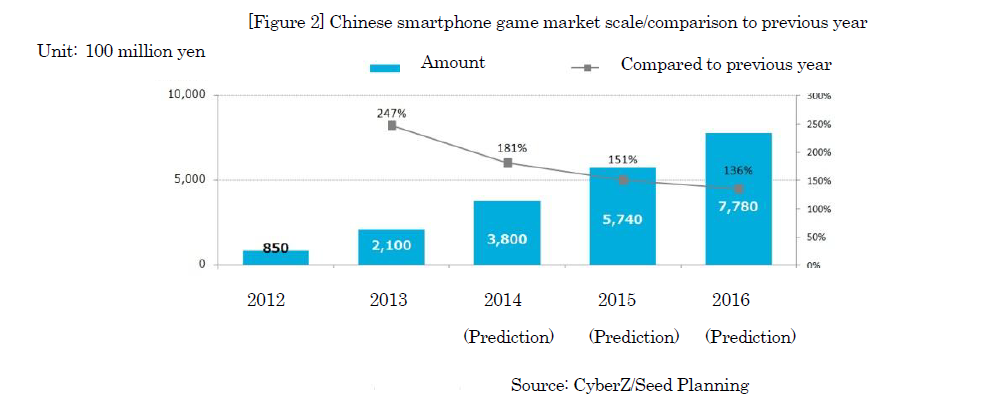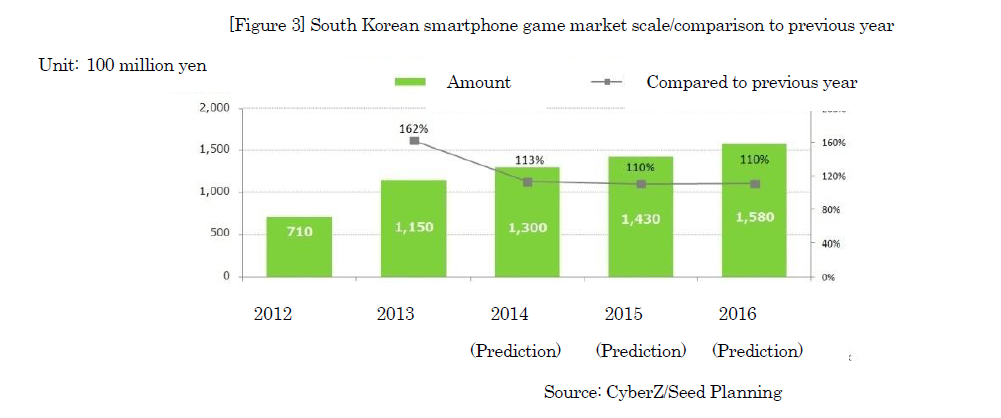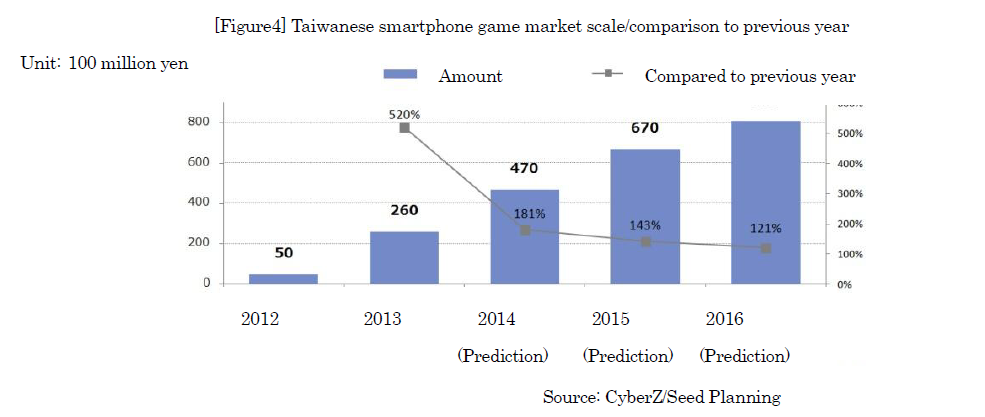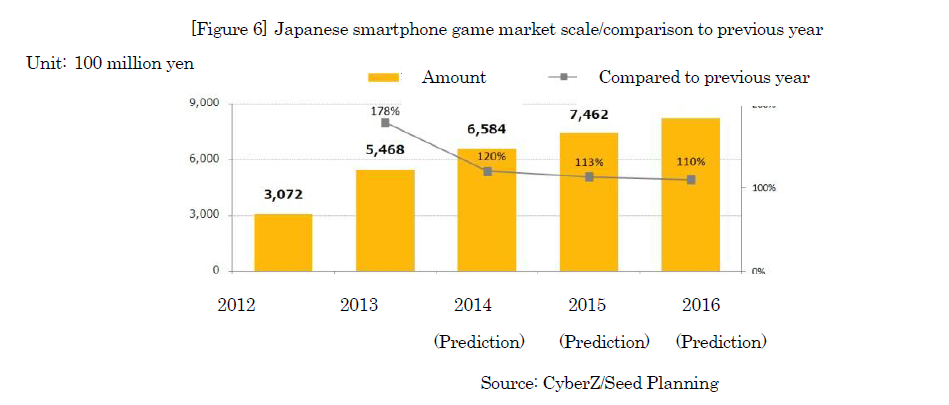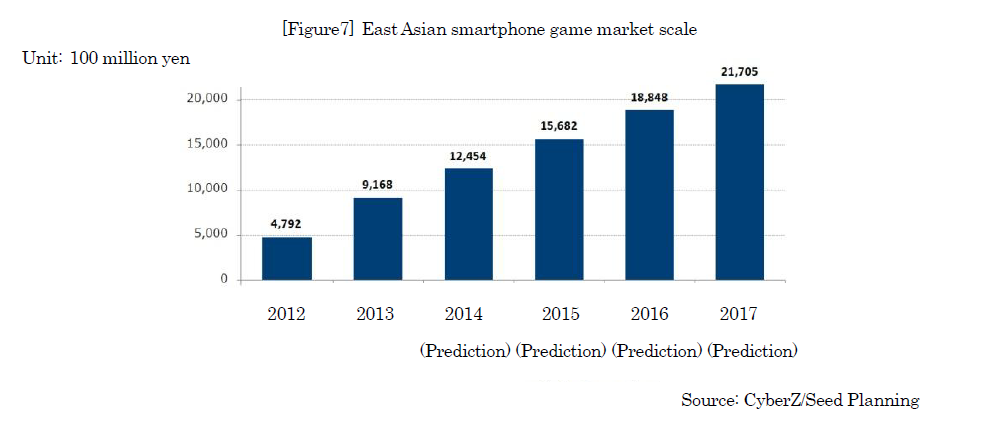CyberZ, Inc. (Head Office: Shibuya-ku, Tokyo; President & CEO: Takahiro Yamauchi), a consolidated subsidiary of CyberAgent, Inc. (Head Office: Shibuya-ku, Tokyo; President: Susumu Fujita; listed on the Tokyo Stock Exchange Mothers market: code 4751), announces that it has conducted a survey on trends in the East Asian smartphone game market together with Seed Planning, Inc. (Head Office: Bunkyo-ku, Tokyo; President: Yoshio Umeda).
[Survey overview and methods]
The target countries and regions for this survey were Japan, China, South Korea, Taiwan, and Hong Kong—parts of Asia where the smartphone adoption rate and number of peripheral service users are expanding at especially rapid speed. The survey method (*1) involved the calculation of country-specific trends and market scale predictions via interviews with local corporations and research on related markets. Estimated market scales (*2) were calculated by totaling smartphone game sales, and the sales of smartphone games by foreign game companies, in the target countries and regions. In this survey, “smartphone game” refers to general games played by users on smartphones. It includes native smartphone apps (*3), smartphone browser games (*4), and games played on tablets. The survey results are as follows.
[1] Scale of the East Asian smartphone game market (2012 – 2016)
The scale of the East Asian smartphone game market in 2013 was 916.8 billion yen (191.3% of the previous year).
Taiwan had the top growth rate, followed by China. Japan occupied the largest portion of the market scale at 59.6%.
The number of smartphone game users in the East Asian smartphone game market is expanding rapidly due to the increasingly widespread usage of smartphones and the establishment of app stores such as Google Play. The purchase amount per user has significantly increased as well. The series of hit titles in the target countries and regions from 2012 to 2013 included puzzle games and running games that can be played in a casual way, as well as puzzles with role-playing game (RPG) elements. Facebook and free voice communication and messaging apps with hundreds of millions of users—including LINE, WeChat, and KakaoTalk—have helped to rapidly popularize smartphone games. Major IT companies are also beginning full-scale efforts related to the smartphone game store business, and an environment has been established for smartphone game purchases by users. At the same time, major game companies have entered the market one after another and launched smartphone games of various genres. As a result, the East Asian smartphone game market scale has rapidly grown to 916.8 billion yen, which was 191.3% of the previous year. The country- and region-specific trends are as follows.
[2] The Chinese smartphone game market
The scale of the Chinese smartphone game market in 2013 was 210 billion yen (247.1% of the previous year).
China comprised 22.9% of the East Asian smartphone game market.
Domestic mobile phone manufacturers in China have rapidly popularized high-spec, low-cost smartphones since around 2012. The number of mobile phone contracts exceeded the 400 million mark in 2013, and the number of smartphone game users is estimated at 300 million (*5). Google Play is not substantively offered in China, but there are many smartphone game stores with original payment functions such as Baidu, Qihoo 360, and UCWeb. Many users tend to download and play games from these stores. Major IT companies began full-scale efforts related to the smartphone game store business in 2013, and an environment has been established for purchases by users. From around 2013 users have shown great support for highly profitable genres such as card battle games (which have been popular since around the middle of 2012), massively multiplayer online role-playing games (MMORPGs) that are also very popular as online PC games, and poker games. Accordingly, together with the increased number of users, the purchase amount per user has also increased. The smartphone game business was started in the latter half of 2013 with WeChat, Tencent’s free voice communication and messaging app that has hundreds of millions of users. In this way, the popularization of smartphone games was facilitated via connections between users of this app. Based on these factors, the Chinese smartphone game market in 2013 was 210 billion yen, which was 247.1% of the previous year.
[3] The South Korean smartphone game market
The scale of the South Korean smartphone game market in 2013 was 115 billion yen (162.0% of the previous year).
South Korea comprised 12.5% of the East Asian smartphone game market.
South Korea is home to the world’s most advanced mobile communication environment, and is one of the countries where smartphones came into widespread usage at the earliest stage. The smartphone adoption rate is roughly 80% of the population of approximately 49 million people (*6). The cultivation of the gaming industry is also a national policy; assistance measures are implemented for businesses, and this industry is managed and regulated. Due to this, many game companies—from major companies to start-ups—have entered the smartphone game market. The South Korean government’s Game Rating Board relaxed regulations on the distribution of smartphone and tablet games in July 2011, abolishing the preliminary review system that had been used until that point and allowing for the open distribution of games. As a result, the distribution of prominent game titles in the smartphone game market has accelerated since 2012. In addition—Kakao, which has an overwhelming domestic share in South Korea—opened a smartphone game store. Via this service, titles such as puzzle RPGs and running games launched by domestic IT start-up companies have become major national hits. These games have acquired new users and broadly popularized smartphone games among all generations. The full-scale popularization of RPG titles began in the second half of 2013, and the purchase amount per user has been on a trend of increase. Based on these factors, the South Korean smartphone game market was 115 billion yen in 2013, which was 162.0% of the previous year.
[4] The Taiwanese smartphone game market
The scale of the Taiwanese smartphone game market in 2013 was 26 billion yen (520.0% of the previous year), with the top growth rate in East Asia.
Taiwan comprised 2.8% of the East Asian smartphone game market.
Smartphones have come into widespread usage in Taiwan; among the population of approximately 23.4 million people (*7), the smartphone ratio is one per person. Meanwhile, Google ceased paid app sales in Taiwan in September 2011 due to the regulations of Taipei’s Consumer Protection Law, so the full-scale formation of the market did not take place until 2012. The government lifted these regulations in 2013, and Google resumed its paid app sales in February of that year, after which the smartphone game market was rapidly established. The utilization rate of social networking services, such as LINE and Facebook, is high in Taiwan, and these services have played a major role in popularizing smartphone games. There is also a tendency to support smartphone games from other countries including Japan, Hong Kong, China, and South Korea. Proactive promotion activities were carried out via social media, and in ways tailored to local needs, for a puzzle RPG that has been offered by a Hong Kong game company since early 2013, which helped popularize this title and make it into a national hit. This drove rapid growth in the market. In addition, RPGs with high profitability have also gained popularity. The domestic game industry has migrated from online PC games to smartphone games. Domestic game companies are offering multiple smartphone titles from the second half of 2013, and the number of titles is on a trend of increase. Based on these factors, the Taiwanese smartphone game market scale in 2013 was 26 billion yen, which was 520.0% of the previous year.
[5] The Hong Kong smartphone game market
The scale of the Hong Kong smartphone game market in 2013 was 19 billion yen (172.7% of the previous year).
Hong Kong comprised 2.1% of the East Asian smartphone game market.
Hong Kong is the region of the world where smartphones are in the most widespread use. The population is slightly over 7.2 million people (*8), and compared to other countries the market scale is limited. On the other hand, the per capita GDP is of the highest level in East Asia, and credit cards are widely used for payments. Accordingly, the game purchase amount per user is assumed to be of a similarly high level as Japan. Chinese and English are the languages used in Hong Kong, so games from Chinese- and English-speaking regions are played frequently. Moreover, game publishers and other parties are promoting game titles from varied regions such as Japan and South Korea. The social media adoption rate is high in Hong Kong, and the utilization rate of Facebook and chat apps (such as WhatsApp) is high. These services play a major role in the popularization of smartphone games. Popular games in 2013 included a puzzle RPG by a Hong Kong game company, a European puzzle game, a sports game from Japan, and a Chinese RPG title. The purchase amount per user also increased. Based on these factors, the Hong Kong smartphone game market scale in 2013 was 19 billion yen, which was 172.7% of the previous year.
[6] The Japanese smartphone game market
The scale of the Japanese smartphone game market in 2013 was 546.8 billion yen (178.0% of the previous year).
Japan comprised 59.6% of the East Asian smartphone game market.
Japan is the country with the largest smartphone game market in East Asia. The adoption rate is over 50% of the population of roughly 130 million people (*9). Japan is also the East Asian country with the greatest room for growth in terms of adoption rate. The market for browser games on feature phones was formed even before smartphones came into widespread usage, and has a unique market structure compared to the rest of the world. The game market has been migrating from browser games to smartphone games from around 2012. In addition, the popularization of native app games has been accelerated since the latter half of 2012, and in 2013 a puzzle RPG game became a national hit title and drove market expansion. In Japan as well, social networking services, such as Facebook and LINE, have served major roles in the popularization of smartphone games. The Japanese smartphone game market scale in 2013 was 546.8 billion yen, which was 178.0% of the previous year.
[7] The East Asian smartphone game market from 2014
The predicted scale of the East Asian smartphone game market in 2014 is 1.2454 trillion yen (135.8% of the previous year).
It is expected to reach the two trillion yen mark—roughly 2.4 times the size of the 2013 market scale—in 2017.
It is expected that the East Asian smartphone game market will expand in 2014—at a high growth rate that drives the global market—due to the increasing number of smartphone users in Japan and China, as well as the increasing purchase amount per user in different countries and regions. In addition to the casual games of the past, it is expected that popular social networking services will serve as strong channels to popularize RPGs and other highly profitable mid-core games (*10), thereby boosting this market expansion. It is also predicted that the increase of smartphone game users in Japan and China, caused by the continual popularization of smartphones, will support market growth. The estimated scale of Japan’s feature phone game market in 2013 was 140 billion yen (*11). Incorporating this and other demand, it is predicted that the market will grow favorably. In South Korea, it is thought that the popularization of smartphone games in the domestic market (via social media channels) has already come full circle, and that the growth rate will be slower than 2013. In 2014, it is predicted that RPG games will gain popularity via a wide variety of channels, and that market growth will be firm. It is expected that appealing game titles from many countries and regions will be brought into Hong Kong—a pilot market for game companies expanding globally—and that growth of a high level will take place. Taiwan is part of the same linguistic area as Hong Kong, and strong connections can be seen between these markets. It is expected that the popularization of domestic game titles—and also game titles from many countries and regions inside and outside of East Asia (including Japan)—will boost market growth, and that market growth of a high level will take place.
From 2015, it is predicted that the market will continue expanding due to factors such as the continual popularization of smartphones in Japan and China, a wider range of game payment functions offered by major IT companies in various countries and regions, the establishment of distribution infrastructure, and a certain portion of the existing online PC game market migrating to the smartphone game market. It is thought that users in various countries and regions will become able to play games from different countries and regions due to the accelerated distribution of smartphone games inside this region on a reciprocal basis. As a result, the East Asian smartphone game market is predicted to reach the 2.1705 trillion yen mark in 2017— roughly 2.4 times the size of the 2013 market scale.
[8] Background of this survey
Due to the rapid growth of the smartphone game market, Japan became number one in the world for app store sales—including via the Mac App Store and Google Play—in December 2013, exceeding the United States (which previously held the top position) for the first time (*12). CyberZ believes that East Asia comprised more than a majority of the worldwide smartphone game market scale in 2013. Based on this background, CyberZ conducted this survey with the goals of accelerating global developments in the smartphone advertising business and maximizing advertising effectiveness by comprehending characteristic smartphone game market trends, future expansion forecasts, and user behavior tendencies in East Asia (including Japan). In the future, CyberZ will continue working to resolve corporations’ issues related to smartphone promotion and improve effectiveness in order to contribute to the growth of the smartphone game market.
■ About CyberZ
CyberZ was established in 2009 as a company specialized in smartphone advertising and marketing. It supports the marketing efforts of advertisers across the world—including in Asia, the US, and EU—from its branches in Tokyo and San Francisco. Force Operation X, the smartphone advertising solution launched by CyberZ in February 2011, was the first tool in Japan that allowed users to measure the effectiveness of smartphone app advertising. CyberZ is also recognized as a Facebook “Mobile Measurement Partners”, and has partnered with one of the world’s largest numbers of major media inside and outside Japan. CyberZ’s services have been adopted by advertisers for more than 3,000 titles. In addition to translation, CyberZ also provides localization services according to the special characteristics of different countries and regions.
■ Survey overview
Implementing entity: CyberZ, Inc.
Period: January to June 2014
Method: Interviews with persons involved in the smartphone game market, data possessed by the implementing entity and survey institution, collection of publically released information
Subject: Smartphone game markets
Survey institution: Seed Planning, Inc.
* When reprinting or utilizing the content of this survey, please include a credit reading, “Source: CyberZ”.
*1 This survey referred to interviews with and information released by businesses involved in the smartphone game industry in the target countries and regions, data possessed by the implementing entity and Seed Planning, and data released by public institutions and other parties in the target countries and regions. The reference data for calculating the market scales of the target countries and regions is listed below, together with the public institutions that provided cooperation.
– China: Survey on the Chinese Smartphone Mobile Game Market by the Japan External Trade Organization (JETRO) (2012 smartphone game market scale and estimated 2013 market scale based on the 2013 market scale until the third quarter minus the value of exports; released in February 2014).
– South Korea: 2013 Republic of Korea Video Game White Paper by the Korea Creative Content Agency (kocca) (estimated the smartphone game market scale based on the 2012 mobile game market scale; the value of exports was deducted and the value of imports was added to calculate the domestic demand amount; released in October 2013).
– Taiwan: Interviews were conducted of local businesses with cooperation from the Taipei Computer Association. CyberZ and Seed Planning estimated the market scale by referring to the results of these interviews and other information. The following standard values were utilized to convert Japanese yen into local currencies.
Chinese yuan 15.90
South Korean won 0.09
Taiwanese dollar 3.28
Hong Kong dollar 12.59
*2 In this survey, “market scale” is defined as the total amount of money paid by users to game companies in order to play smartphone games. It includes payment handling charges as well as handling charges paid to app stores and game stores. The market scales of the target countries and regions are the amount of demand in these countries and regions. Accordingly, “market scale” excludes the consumption amount by foreign game users for smartphone games provided by game companies in the target countries and regions (export amount), and includes the consumption amount by users in the target countries and regions for smartphone games provided by foreign game companies (import amount).
*3 “Native smartphone app” refers to game software that can be purchased via app stores such as the Mac App Store and Google Play. It includes web apps.
*4 “Smartphone browser game” refers to games played via a user’s game portal MyPage. These games are provided and played via smartphone web browsers.
*5 Survey on the Chinese Smartphone Mobile Game Market by JETRO (estimated by CyberZ and Seed Planning based on the February 2014 announcement on the number of Chinese mobile game users [293.17 million in the first quarter of 2013]).
*6: Reference data source: The World Factbook, CIA.
*7: Reference data source: The World Factbook, CIA.
*8: Reference data source: The Government of the Hong Kong Special Administrative Region of the People’s Republic of China.
*9: Reference data source: The World Factbook, CIA.
*10 Refers to general games positioned in between “casual” and “hardcore” games (such as challenging RPGs that are often played on PCs).
*11 Estimated by CyberZ and Seed Planning.
*12 Source: App Annie (an American app market survey company) (as of December 11, 2013).
■ Company profile
Company name: CyberZ, Inc. http://cyber-z.co.jp/
Location: 16F Shibuya Mark City, 1-12-1 Dogenzaka, Shibuya-ku, Tokyo
Established: April 1, 2009
Representative: President & CEO: Takahiro Yamauchi
Services: Smartphone advertising

